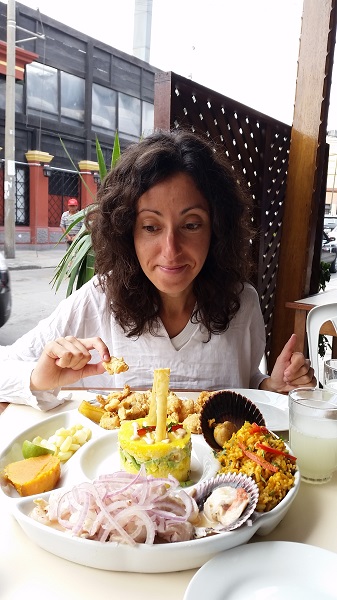 Lima e' stata la città più rumorosa e trafficata tra tutte le capitali visitate fino ad ora! Anche più di La Paz e Buenos Aires. I limeñi hanno il clacson facile suonano per tutto senza un criterio, o se ce l'hanno non lo abbiamo capito!
Tuttavia, ha il centro storico dichiarato patrimonio dell'umanita' ed e' la capitale culinaria di tutto il Sud America, e soprattutto per questo le si perdona tutto.
La 'comida' (cibo) peruviana e' semplicemente divina, succulenta e sofisticata. A Lima abbiamo masticato quasi 24 ore no-stop – in previsione dei tempi 'duri' dell'Amazzonia.
Abbiamo alloggiato a Barranco, il quartiere bohemo della città, dove ci sono locali notturni, ristoranti a non finire e caffè deliziosi. Noi abbiamo scelto una stanza in una casa di tre piani dove vivevano altri 8 ragazzi provenienti da tutto il mondo ma che momentaneamente vivono a Lima per studio o lavoro. Interessante parlare con 'gringos' che vivono la città da locali, decisamente un punto di vista meno superficiale di un turista.
Torniamo al tema principale: Il cibo.
Ovviamente non si può non menzionare il cevice limeño fatto con pesce fresco o anche frutti di mare crudi, una spruzzatina di lime, cipolla, un po di aji (tipo di peperoncino) e il gioco e' fatto. Di solito viene accompagnato con yucca o un tipo di patata, bolliti o fritti, con choclo (tipo di mais a chicchi grandi).
Come antipastino ti portano sempre il leche de tigre (latte di tigre) che non e' altro che la scolatura o il condimento del cevice mischiato con tutti gli ingredienti. Il simpatico cameriere de 'El Muelle' di Barranco ci ha spiegato che il segreto e' non far marinare o cuocere il pesce con il lime/limone per più di 5 minuti, quindi la regola e' 'fatto e mangiato'.
Abbiamo potuto apprezzare diverse varianti di cevice durante il nostro viaggio e quello di Claudia in Cile e' al primo posto con quello di Lima!
Altra leccornia provata e' stata un tortino di mais cucinato come polenta e servito freddo con dentro avocado, gamberi e maionese, un piatto super delizioso.
Lima e' stata la città più rumorosa e trafficata tra tutte le capitali visitate fino ad ora! Anche più di La Paz e Buenos Aires. I limeñi hanno il clacson facile suonano per tutto senza un criterio, o se ce l'hanno non lo abbiamo capito!
Tuttavia, ha il centro storico dichiarato patrimonio dell'umanita' ed e' la capitale culinaria di tutto il Sud America, e soprattutto per questo le si perdona tutto.
La 'comida' (cibo) peruviana e' semplicemente divina, succulenta e sofisticata. A Lima abbiamo masticato quasi 24 ore no-stop – in previsione dei tempi 'duri' dell'Amazzonia.
Abbiamo alloggiato a Barranco, il quartiere bohemo della città, dove ci sono locali notturni, ristoranti a non finire e caffè deliziosi. Noi abbiamo scelto una stanza in una casa di tre piani dove vivevano altri 8 ragazzi provenienti da tutto il mondo ma che momentaneamente vivono a Lima per studio o lavoro. Interessante parlare con 'gringos' che vivono la città da locali, decisamente un punto di vista meno superficiale di un turista.
Torniamo al tema principale: Il cibo.
Ovviamente non si può non menzionare il cevice limeño fatto con pesce fresco o anche frutti di mare crudi, una spruzzatina di lime, cipolla, un po di aji (tipo di peperoncino) e il gioco e' fatto. Di solito viene accompagnato con yucca o un tipo di patata, bolliti o fritti, con choclo (tipo di mais a chicchi grandi).
Come antipastino ti portano sempre il leche de tigre (latte di tigre) che non e' altro che la scolatura o il condimento del cevice mischiato con tutti gli ingredienti. Il simpatico cameriere de 'El Muelle' di Barranco ci ha spiegato che il segreto e' non far marinare o cuocere il pesce con il lime/limone per più di 5 minuti, quindi la regola e' 'fatto e mangiato'.
Abbiamo potuto apprezzare diverse varianti di cevice durante il nostro viaggio e quello di Claudia in Cile e' al primo posto con quello di Lima!
Altra leccornia provata e' stata un tortino di mais cucinato come polenta e servito freddo con dentro avocado, gamberi e maionese, un piatto super delizioso.
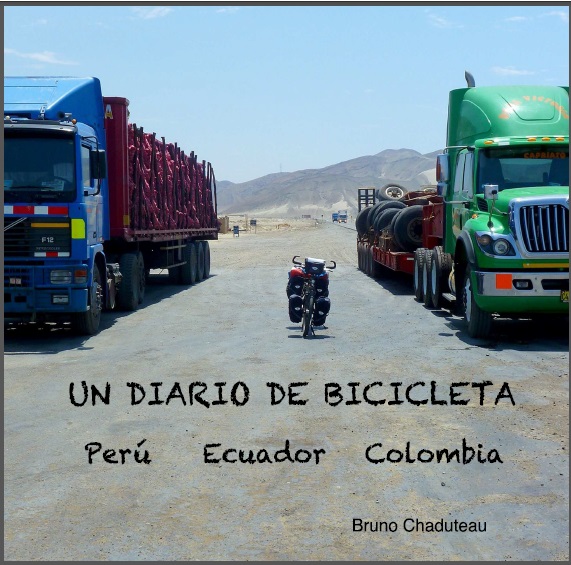 Un posto sfizioso e' 'La Lucha', 'una sandwicheria criolla' (panineria locale) che si trova nella piazza principale a Miraflores, dove servono succhi di frutta super freschi e giganti con panini croccanti e gustosi.
Questo posto ci e' piaciuto soprattutto per la compagnia: Bruno, compañero incontrato durante l'escursione alle isole galleggianti a Puno; arrivato di corsa durante la pausa pranzo per darci tante e preziose informazioni su Lima e soprattutto sulla Colombia, mappando un itinerario personalizzato.
Grazie Bruno Chaduteau per tutto, a presto 🙂
(Consiglio di lettura: Un diario de bicicletta, un delizioso racconto del viaggio di Bruno fatto in bici da Lima a Bogota', Colombia, passando per l'Ecuador. Scaricabile gratuitamente qui - e' in spagnolo:
http://www.blurb.com/b/3386033-un-diario-de-bicicleta )
Siamo stati 5 giorni a Lima camminando molto visto che il traffico e' imbarazzante e limitante sia per gli autobus che per i taxi: ci e' capitato che dal centro si rifiutassero di riportarci a Barranco circa 15-20 minuti normalmente di macchina, con il traffico di ore.
Un posto sfizioso e' 'La Lucha', 'una sandwicheria criolla' (panineria locale) che si trova nella piazza principale a Miraflores, dove servono succhi di frutta super freschi e giganti con panini croccanti e gustosi.
Questo posto ci e' piaciuto soprattutto per la compagnia: Bruno, compañero incontrato durante l'escursione alle isole galleggianti a Puno; arrivato di corsa durante la pausa pranzo per darci tante e preziose informazioni su Lima e soprattutto sulla Colombia, mappando un itinerario personalizzato.
Grazie Bruno Chaduteau per tutto, a presto 🙂
(Consiglio di lettura: Un diario de bicicletta, un delizioso racconto del viaggio di Bruno fatto in bici da Lima a Bogota', Colombia, passando per l'Ecuador. Scaricabile gratuitamente qui - e' in spagnolo:
http://www.blurb.com/b/3386033-un-diario-de-bicicleta )
Siamo stati 5 giorni a Lima camminando molto visto che il traffico e' imbarazzante e limitante sia per gli autobus che per i taxi: ci e' capitato che dal centro si rifiutassero di riportarci a Barranco circa 15-20 minuti normalmente di macchina, con il traffico di ore.
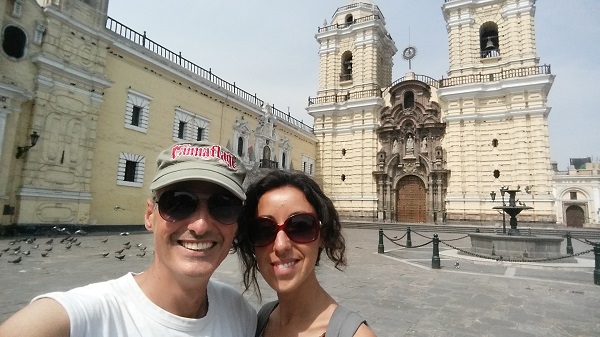 Non ci siamo fatti mancare il tour gratuito a piedi del centro di Lima con la guida che vive con le mance, stesso sistema che abbiamo trovato in altre città sudamericane. Quindi abbiamo visto per primo la piazza centrale, Plaza de Las Armas, con il cambio della guardia davanti al palazzo del governo.
La particolarità di questa cerimonia e' che ogni giorno la banda suona musiche diverse per intrattenere i tanti turisti che accorrono per assistere: noi abbiamo ascoltato la colonna sonora di Rocky I. Nella piazza centrale c'e' anche il municipio da dove San Martin proclamo' l'indipendenza del paese; qui sono esposte tre bandiere: quella del Peru, quella di Lima e l'altra dell'unione andina che assomiglia tanto alla bandiera della pace (o della lotta alla parità dei diritti degli omosessuali)...stanno parecchio avanti 🙂
La passeggiata e' continuata con la vecchia stazione del treno ora sede della posta, poi la chiesa di S. Domenico, la Cattedrale e il mercato centrale dove abbiamo assaggiato (a stomaco vuoto prima di pranzo) tre tipi di Pisco, che e' il liquore nazionale – come anche in Cile, praticamente la nostra grappa.
Non ci siamo fatti mancare il tour gratuito a piedi del centro di Lima con la guida che vive con le mance, stesso sistema che abbiamo trovato in altre città sudamericane. Quindi abbiamo visto per primo la piazza centrale, Plaza de Las Armas, con il cambio della guardia davanti al palazzo del governo.
La particolarità di questa cerimonia e' che ogni giorno la banda suona musiche diverse per intrattenere i tanti turisti che accorrono per assistere: noi abbiamo ascoltato la colonna sonora di Rocky I. Nella piazza centrale c'e' anche il municipio da dove San Martin proclamo' l'indipendenza del paese; qui sono esposte tre bandiere: quella del Peru, quella di Lima e l'altra dell'unione andina che assomiglia tanto alla bandiera della pace (o della lotta alla parità dei diritti degli omosessuali)...stanno parecchio avanti 🙂
La passeggiata e' continuata con la vecchia stazione del treno ora sede della posta, poi la chiesa di S. Domenico, la Cattedrale e il mercato centrale dove abbiamo assaggiato (a stomaco vuoto prima di pranzo) tre tipi di Pisco, che e' il liquore nazionale – come anche in Cile, praticamente la nostra grappa.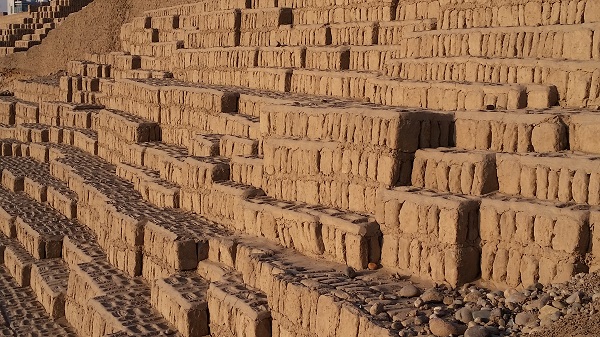 Siamo anche entrati a Huaca Pucllana nel quartiere di Miraflores, che e' un sito archeologico appartenente alla cultura Lima, che per prima lo ha abitato dal 200 al 700 d.c. e successivamente dalla popolazione Wari. Il sito consiste in una piramide con 7 piazze dove ancora si scava per studiare gli eventi di quel tempo. Per esempio ci sono dei buchi sul suolo delle piazze che stanno a testimoniare la consuetudine di fare offerte e porle nel suolo; come anche corpi mummificati di bambini sacrificati in onore delle divinita'. La visita al sito e' molto gradevole tra scavi, riproduzioni della vita e delle cerimonie con statue in legno, ma anche la sue flora e fauna: infatti nella parte posteriore del sito hanno organizzato un orto con le piante tipiche peruviane e ci sono anche recinti con esemplari di animali tipici, come il lama, alpaca e porcellino d'India (commestibile per I peruviani, come per noi il coniglio).
Altra curiosità: nel museo vicino alla chiesa di San Francesco c'è una riproduzione del quadro de 'Ultima cena' ma servito nel piatto centrale il cuy (porcellino d'India).
Siamo anche entrati a Huaca Pucllana nel quartiere di Miraflores, che e' un sito archeologico appartenente alla cultura Lima, che per prima lo ha abitato dal 200 al 700 d.c. e successivamente dalla popolazione Wari. Il sito consiste in una piramide con 7 piazze dove ancora si scava per studiare gli eventi di quel tempo. Per esempio ci sono dei buchi sul suolo delle piazze che stanno a testimoniare la consuetudine di fare offerte e porle nel suolo; come anche corpi mummificati di bambini sacrificati in onore delle divinita'. La visita al sito e' molto gradevole tra scavi, riproduzioni della vita e delle cerimonie con statue in legno, ma anche la sue flora e fauna: infatti nella parte posteriore del sito hanno organizzato un orto con le piante tipiche peruviane e ci sono anche recinti con esemplari di animali tipici, come il lama, alpaca e porcellino d'India (commestibile per I peruviani, come per noi il coniglio).
Altra curiosità: nel museo vicino alla chiesa di San Francesco c'è una riproduzione del quadro de 'Ultima cena' ma servito nel piatto centrale il cuy (porcellino d'India).
 La camminata dal cetro fino a Barranco e' molto bella perché si costeggia la costa, avendo da un lato l'oceano e dall'altra la città dei quartieri di Miraflores e Barranco che sono molto ordinati, chicchettosi e turistici, pieni di vita e gallerie d'arte. Ci hanno fatto notare che la vera Lima inizia dopo il fiume che taglia la città, dove si trovano le favelas ed i quartieri popolari.
Camminando lungo la costa si attraversano diversi parchi, come il famoso parco dell'Amore, e scogliere da dove ci si lancia con il parapendio e deltaplano.
Il tramonto da qui e' bellissimo, quando la tipica nebbia limena lo permette.
La camminata dal cetro fino a Barranco e' molto bella perché si costeggia la costa, avendo da un lato l'oceano e dall'altra la città dei quartieri di Miraflores e Barranco che sono molto ordinati, chicchettosi e turistici, pieni di vita e gallerie d'arte. Ci hanno fatto notare che la vera Lima inizia dopo il fiume che taglia la città, dove si trovano le favelas ed i quartieri popolari.
Camminando lungo la costa si attraversano diversi parchi, come il famoso parco dell'Amore, e scogliere da dove ci si lancia con il parapendio e deltaplano.
Il tramonto da qui e' bellissimo, quando la tipica nebbia limena lo permette.
Peru – Lima Lima was the noisiest city of all capitals visited so far! It has even more traffic of La Paz and Buenos Aires. The Limeni have the easy horn to play without a rule, or if they have it we didn't understand it!
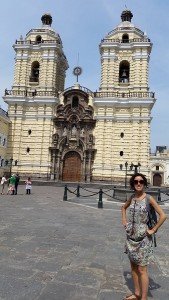 However, the old town is declared heritage of humanity and it is the culinary capital of the whole South America; so especially for this we can forgive everything.
The Peruvian 'comida' (food) is simply divine, succulent and sophisticated. In Lima we chewed almost 24 hours non-stop - in anticipation of the 'hard' period in the Amazon.
We stayed in Barranco, the Boheme district of the city, where there are nightclubs, many restaurants and delicious coffee shops. We chose a room in a three-story house, where there were eight other tenants from all over the world, but currently living in Lima to study or work. Interesting to talk with 'gringos' living the city as locals, we got a much less superficial point of view than a tourist.
Let's go back to the main theme: The food.
Obviously I have to mention the cevice limeño made with fresh raw seafood, a squeeze of lime, onion, a bit of aji (type of chilli) and the game is done. Usually it accompanied with yucca or a type of potato, boiled or fried, with choclo (corn with large grains).
As appetiser, they always bring the leche de tigre (tiger's milk) that is nothing else than the dressing left of the cevice, mixed with all the ingredients. The friendly waiter de 'El Muelle' in Barranco explained that the secret is not to marinate or cook the fish with lime/lemon for more than 5 minutes, so the rule is 'made and eaten'.
We could appreciate different variants of cevice during our trip and that one made by Claudia in Chile is on the first place with the Limeno one!
Another delicacy, we tried, was a pie corn cooked as polenta and served cold with avocado, shrimp and mayonnaise inside, a super delicious dish.
However, the old town is declared heritage of humanity and it is the culinary capital of the whole South America; so especially for this we can forgive everything.
The Peruvian 'comida' (food) is simply divine, succulent and sophisticated. In Lima we chewed almost 24 hours non-stop - in anticipation of the 'hard' period in the Amazon.
We stayed in Barranco, the Boheme district of the city, where there are nightclubs, many restaurants and delicious coffee shops. We chose a room in a three-story house, where there were eight other tenants from all over the world, but currently living in Lima to study or work. Interesting to talk with 'gringos' living the city as locals, we got a much less superficial point of view than a tourist.
Let's go back to the main theme: The food.
Obviously I have to mention the cevice limeño made with fresh raw seafood, a squeeze of lime, onion, a bit of aji (type of chilli) and the game is done. Usually it accompanied with yucca or a type of potato, boiled or fried, with choclo (corn with large grains).
As appetiser, they always bring the leche de tigre (tiger's milk) that is nothing else than the dressing left of the cevice, mixed with all the ingredients. The friendly waiter de 'El Muelle' in Barranco explained that the secret is not to marinate or cook the fish with lime/lemon for more than 5 minutes, so the rule is 'made and eaten'.
We could appreciate different variants of cevice during our trip and that one made by Claudia in Chile is on the first place with the Limeno one!
Another delicacy, we tried, was a pie corn cooked as polenta and served cold with avocado, shrimp and mayonnaise inside, a super delicious dish.
 A delicious place was 'La Lucha', a sandwicheria criolla (local sandwiches place) located in the main square in Miraflores, where they serve fresh and super giant juices with crispy and tasty sandwiches.
We liked this place especially for the company: Bruno, a compañero that we met during the excursion at the floating islands in Puno; he came running during his lunch break to give to us many and valuable information about Lima and especially about Colombia, mapping even a personalised itinerary.
Thanks Bruno Chaduteau for all, see you soon 🙂
(Recommended reading: 'A Diary of bicycle', a delightful story of the journey of Bruno done by bike from Lima to Bogota', in Colombia, through Ecuador. Downloadable for free here – it's in Spanish:
http://www.blurb.com/b/3386033-un-diario-de-bicicleta )
We stayed 5 days in Lima walking a lot as the traffic is embarrassing and limiting both the buses and the taxis: here it happened that from the center taxi drivers refused to take us back to Barranco - normally about 15-20 minutes by car, but hours with the traffic.
A delicious place was 'La Lucha', a sandwicheria criolla (local sandwiches place) located in the main square in Miraflores, where they serve fresh and super giant juices with crispy and tasty sandwiches.
We liked this place especially for the company: Bruno, a compañero that we met during the excursion at the floating islands in Puno; he came running during his lunch break to give to us many and valuable information about Lima and especially about Colombia, mapping even a personalised itinerary.
Thanks Bruno Chaduteau for all, see you soon 🙂
(Recommended reading: 'A Diary of bicycle', a delightful story of the journey of Bruno done by bike from Lima to Bogota', in Colombia, through Ecuador. Downloadable for free here – it's in Spanish:
http://www.blurb.com/b/3386033-un-diario-de-bicicleta )
We stayed 5 days in Lima walking a lot as the traffic is embarrassing and limiting both the buses and the taxis: here it happened that from the center taxi drivers refused to take us back to Barranco - normally about 15-20 minutes by car, but hours with the traffic.
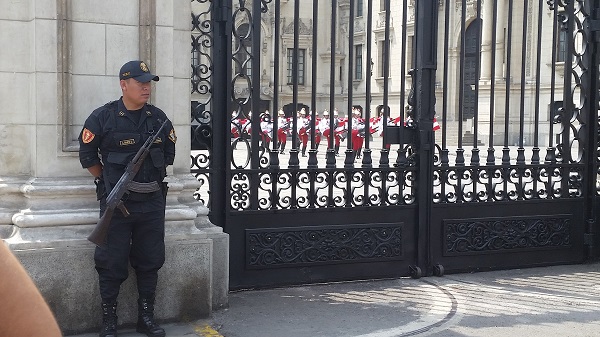 We did the free walking tour of downtown with the guide who lives on tips; the same system that we found in other South American cities. With the group, we saw first the central square, Plaza de Las Armas, with the changing of the guard in front of the government building.
The special feature of this ceremony is that every day the band plays different music to entertain the many tourists who come to see it: we listened to the soundtrack of Rocky I.
In the central square there's also the town hall from where San Martin proclaimed the independence of the country; here they expose three flags: one of Peru, one of Lima and the other of the Andean union, which looks like the flag of peace (or the symbol flag for the equal rights of homosexuals)... They are quite ahead 🙂
The walk continued going to the old train station, now housing the post office, then the church of S. Domenico, the Cathedral and the central market where we tasted (on an empty stomach before lunch) three types of Pisco, the national liquor - as well as in Chile, practically the Italian grappa.
We did the free walking tour of downtown with the guide who lives on tips; the same system that we found in other South American cities. With the group, we saw first the central square, Plaza de Las Armas, with the changing of the guard in front of the government building.
The special feature of this ceremony is that every day the band plays different music to entertain the many tourists who come to see it: we listened to the soundtrack of Rocky I.
In the central square there's also the town hall from where San Martin proclaimed the independence of the country; here they expose three flags: one of Peru, one of Lima and the other of the Andean union, which looks like the flag of peace (or the symbol flag for the equal rights of homosexuals)... They are quite ahead 🙂
The walk continued going to the old train station, now housing the post office, then the church of S. Domenico, the Cathedral and the central market where we tasted (on an empty stomach before lunch) three types of Pisco, the national liquor - as well as in Chile, practically the Italian grappa.
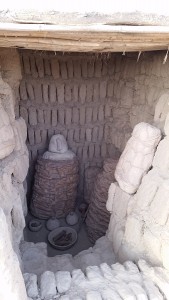 We also entered at Huaca Pucllana in Miraflores district, which is an archaeological site belonging to the Lima culture, who first occupied the place from 200 to 700 AD, and then by the Wari people. The site consists of a pyramid with 7 squares, where they are still digging to study the events of that time. For example, there are holes on the ground of the squares that testify the custom of bidding offers; and also, on the ground, mummified bodies of children sacrificed in honour of the gods.
The visit to the site was very pleasant between excavations, reproductions of life and ceremonies with wooden statues, but also for its flora and fauna: in fact in the back of the site there is a veggie garden with typical Peruvian plants and there are fences with examples of typical animals such as llama, alpaca and guinea pig (edible for Peruvians, as for us the rabbit).
Another curiosity: in the museum next to the church of San Francesco there is a reproduction of the painting 'Last Supper', but served on the central plate there is a cuy (guinea pig).
We also entered at Huaca Pucllana in Miraflores district, which is an archaeological site belonging to the Lima culture, who first occupied the place from 200 to 700 AD, and then by the Wari people. The site consists of a pyramid with 7 squares, where they are still digging to study the events of that time. For example, there are holes on the ground of the squares that testify the custom of bidding offers; and also, on the ground, mummified bodies of children sacrificed in honour of the gods.
The visit to the site was very pleasant between excavations, reproductions of life and ceremonies with wooden statues, but also for its flora and fauna: in fact in the back of the site there is a veggie garden with typical Peruvian plants and there are fences with examples of typical animals such as llama, alpaca and guinea pig (edible for Peruvians, as for us the rabbit).
Another curiosity: in the museum next to the church of San Francesco there is a reproduction of the painting 'Last Supper', but served on the central plate there is a cuy (guinea pig).
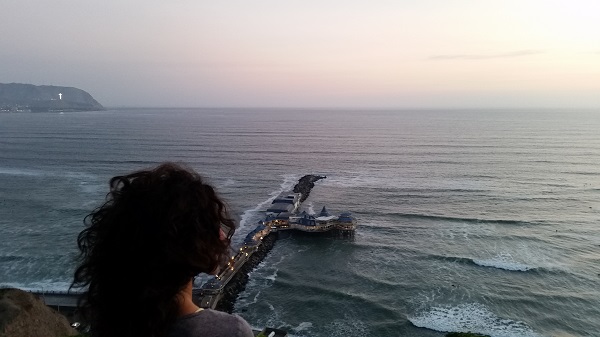 The walk from the center to Barranco is very beautiful, because it runs along the coast, having on one side the ocean and on the other the city districts of Miraflores and Barranco; those two are very tight, chic and tourist, full of life and art galleries. They pointed out that the real Lima begins after the river that divides the city, where there are the favelas and the popular neighbourhoods.
Walking along the coast was great as we passed through several parks, such as the famous park of Love, and cliffs where people do paragliding and hanggliding.
The sunset from here is beautiful, when the typical limena fog permits.
The walk from the center to Barranco is very beautiful, because it runs along the coast, having on one side the ocean and on the other the city districts of Miraflores and Barranco; those two are very tight, chic and tourist, full of life and art galleries. They pointed out that the real Lima begins after the river that divides the city, where there are the favelas and the popular neighbourhoods.
Walking along the coast was great as we passed through several parks, such as the famous park of Love, and cliffs where people do paragliding and hanggliding.
The sunset from here is beautiful, when the typical limena fog permits. 